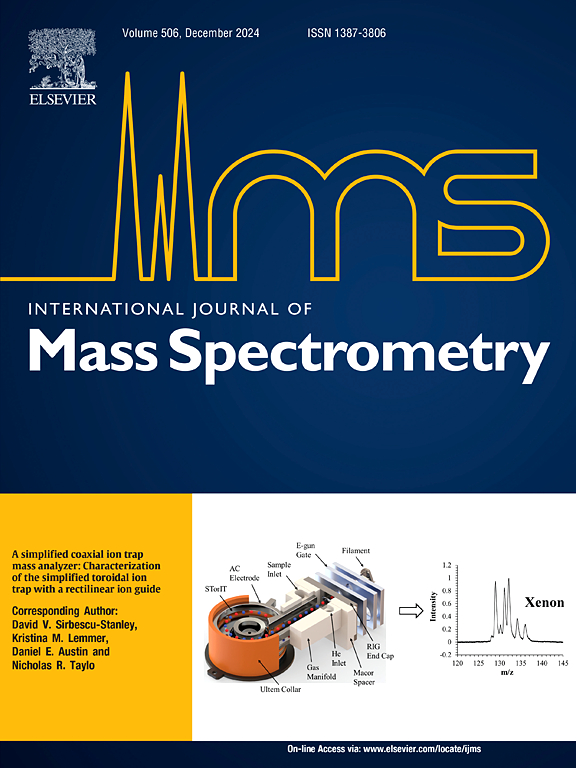Chirality effects on the intrinsic acidity of isomeric tripeptides containing a D/L-Cysteine on the N-terminus: CAA and dCAA
IF 1.7
3区 化学
Q3 PHYSICS, ATOMIC, MOLECULAR & CHEMICAL
引用次数: 0
Abstract
Chirality effects on the intrinsic gas-phase acidity of oligopeptides have been studied using a pair of stereoisomeric tripeptides consisting of a D/L-cysteine (C) and two residues of alanine (A): CAA and dCAA, where the C-terminus is amidated. Mass spectrometry measurements through bracketing via collision-induced dissociation clearly show that CAA is a stronger gas-phase acid than dCAA. Quantitative values of the acidity were determined using the extended Cooks kinetic method. The resulting deprotonation enthalpy (ΔacidH) for CAA is 326.2 kcal/mol (1364.7 kJ/mol) and for dCAA it is 326.8 kcal/mol (1367.6 kJ/mol). The corresponding gas-phase acidity (ΔacidG) for CAA is 321.3 kcal/mol (1344.2 kJ/mol) and for dCAA it is 322.0 kcal/mol (1347.3 kJ/mol). Changing the N-terminal cysteine from the L-form to the D-form reduces the gas-phase acidity by about 0.6 kcal/mol (2.5 kJ/mol). Extensive conformational searches followed by quantum chemical calculations at the ωB97X-D/6-311+G(d,p) level of theory yielded a set of lowest energy conformations for each peptide species. Theoretical gas-phase acidities calculated using the Boltzmann averaged conformational contributions are in good agreement with the experimental data. The shift in the acidity is likely due to the conformational effect induced by D-cysteine, which increases the stability of the neutral dCAA, and hence reduces its acidity. A chirality change on a single amino acid can have a noticeable effect on the biochemical properties of peptides and proteins.

手性对n端含D/ l -半胱氨酸的异构体三肽固有酸度的影响:CAA和dCAA
用一对由D/ l -半胱氨酸(C)和丙氨酸(a)的两个残基:CAA和dCAA组成的立体异构体三肽研究了手性对寡肽固有气相酸度的影响,其中C端被修饰。通过碰撞诱导解离进行的质谱测量清楚地表明,CAA是比dCAA更强的气相酸。用扩展库克斯动力学法测定了酸度的定量值。CAA的脱质子焓(ΔacidH)为326.2 kcal/mol (1364.7 kJ/mol), dCAA的脱质子焓为326.8 kcal/mol (1367.6 kJ/mol)。相应的CAA气相酸度(ΔacidG)为321.3 kcal/mol (1344.2 kJ/mol), dCAA气相酸度为322.0 kcal/mol (1347.3 kJ/mol)。将n端半胱氨酸从l型转变为d型,可使气相酸度降低约0.6 kcal/mol (2.5 kJ/mol)。广泛的构象搜索之后,在ωB97X-D/6-311+G(d,p)理论水平上进行量子化学计算,得出了每种肽种的一组最低能量构象。用玻尔兹曼平均构象贡献计算的理论气相酸度与实验数据吻合良好。酸度的变化可能是由于d -半胱氨酸引起的构象效应,它增加了中性dCAA的稳定性,从而降低了它的酸度。单个氨基酸的手性变化会对多肽和蛋白质的生化特性产生显著影响。
本文章由计算机程序翻译,如有差异,请以英文原文为准。
求助全文
约1分钟内获得全文
求助全文
来源期刊
CiteScore
3.60
自引率
5.60%
发文量
145
审稿时长
71 days
期刊介绍:
The journal invites papers that advance the field of mass spectrometry by exploring fundamental aspects of ion processes using both the experimental and theoretical approaches, developing new instrumentation and experimental strategies for chemical analysis using mass spectrometry, developing new computational strategies for data interpretation and integration, reporting new applications of mass spectrometry and hyphenated techniques in biology, chemistry, geology, and physics.
Papers, in which standard mass spectrometry techniques are used for analysis will not be considered.
IJMS publishes full-length articles, short communications, reviews, and feature articles including young scientist features.

 求助内容:
求助内容: 应助结果提醒方式:
应助结果提醒方式:


